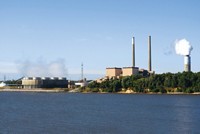Advertisement
Grab your lab coat. Let's get started
Welcome!
Welcome!
Create an account below to get 6 C&EN articles per month, receive newsletters and more - all free.
It seems this is your first time logging in online. Please enter the following information to continue.
As an ACS member you automatically get access to this site. All we need is few more details to create your reading experience.
Not you? Sign in with a different account.
Not you? Sign in with a different account.
ERROR 1
ERROR 1
ERROR 2
ERROR 2
ERROR 2
ERROR 2
ERROR 2
Password and Confirm password must match.
If you have an ACS member number, please enter it here so we can link this account to your membership. (optional)
ERROR 2
ACS values your privacy. By submitting your information, you are gaining access to C&EN and subscribing to our weekly newsletter. We use the information you provide to make your reading experience better, and we will never sell your data to third party members.
Environment
Coal Power Plant Emissions To Be Cut
Regulations: EPA issues new mercury, toxic air emissions rule
by Jeff Johnson
December 22, 2011
After a long, tortured path stretching back to requirements in the 1990 Clean Air Act, the Environmental Protection Agency issued regulations yesterday to require coal-fired and oil-fired electric power plants to reduce their emissions of mercury, arsenic, cyanide, and other toxic air pollution.
The regulation has sharply divided electric utilities, manufacturers , and members of Congress.
EPA estimates the safeguards will annually prevent as many as 11,000 premature deaths and 4,700 heart attacks as well as 130,000 cases of childhood asthma and about 6,300 cases of acute bronchitis among children. The impact on children of these emissions was underscored in the agency’s announcement, which EPA Administrator Lisa P. Jackson made at the Children’s Medical Center in Washington, D.C.
Childhood asthma, Jackson said, “is especially significant to me as a mother.” Her two sons have struggled with asthma, she said in a blog posting. Her youngest son, she added, spent his first Christmas in a hospital “fighting to breathe.” The benefits of the Clean Air Act, she said, “are not just statistics and abstract concepts.”
The new regulations affect 1,400 power plants, 1,100 of which are large, coal-fired electric power plants. EPA estimates 40% of these coal units do not use advanced pollution control equipment to cut emissions and must install pollution control devices. Some are 50 or more years old. Currently, half the nation’s electricity comes from coal-fired power plants. The regulation is likely to continue the trend of utilities moving away from reliance on units lacking pollution controls.
Coal-fired power plants are the largest remaining source of toxic air pollutants, according to EPA figures, and are responsible for half of the mercury emissions and 75% of acid gas emissions in the U.S. Over the years, mercury emissions have been a growing concern of the agency’s, primarily due to methyl mercury’s impact on neurological development of children and the developing fetus.
Other major mercury emissions sources—medical waste incinerators and municipal waste incinerators—have successfully cut emissions in the past as a result of the Clean Air Act, EPA notes, and only power plants remain.
To meet pollution limits in the new regulation, coal-fired power plants must install a combination of technologies that could include selective catalytic reduction equipment, fabric filters, and injected activated carbon to capture mercury and other toxic emissions. The technologies, called “maximum achievable control technologies,” are based on pollution limits that have been achieved by the top 12% of operating facilities. About half the nation’s coal-fired power plants have already installed the equipment, EPA estimates.
The cost is expected to be about $9.6 billion for the power industry and result in $37 billion to $90 billion in health benefits, according to the agency. EPA predicts thousands of manufacturing, engineering, installation, and maintenance and operational jobs will be created, including some 46,000 short term construction jobs and 8,000 long-term utility position.
Utilities will have three years to install the equipment with the option of adding one more year if necessary for difficult technical installations.
Utilities were split on the regulations with those that have already installed equipment supporting EPA and coal-reliant utilities with old plants and uncontrolled emissions—such as Southern Co. and American Electric Power—warning that the regulations were too expensive and they would have to shut plants down.
Several members of Congress have also said they will seek legislation to block EPA’s action. Over the 21 years since the Clean Air Act passed, some 900,000 comments have been received by EPA concerning its approach to regulating this industry and the regulation has been the subject of several legal challenges.




Join the conversation
Contact the reporter
Submit a Letter to the Editor for publication
Engage with us on Twitter